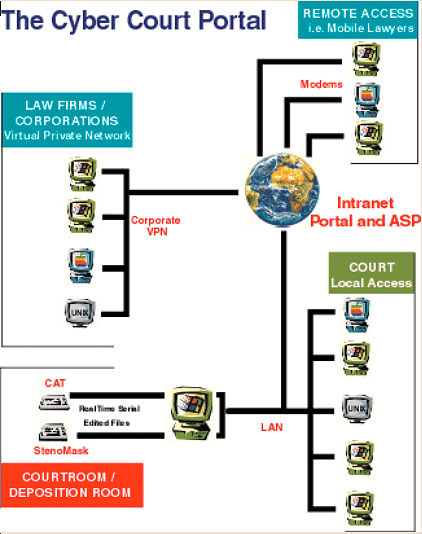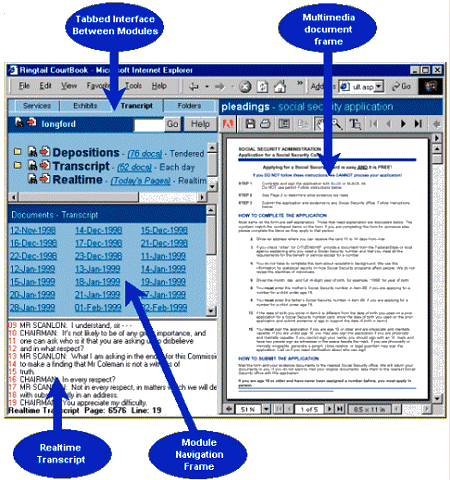JILT 2000 (1) - O'Brien & Wilson
Virtual Travel on the Justice Information Highway
Eddie O'Brien and James Wilson
Ringtail Solutions
Australia
Delivered as a slide presentation at the 2nd AustLII Conference on Computerisation of Law via the Internet, Australasian Legal Information Institute (AustLII), University of Technology, Sydney, Australia, 21-23 July 1999, and in this revised paper form at the LegalTech Conference in New York, 24-26 January 2000 .
|
|
|||||||||||||||||||||||||||||||||||||||||||||||
1. Introduction
'I took the road less traveled and it made all the difference.' – Robert Frost.
Justice information systems are under going radical change. The legal industry is now embarked on a virtual journey on the information highway.
The opportunity of virtual court, hearing or deposition rooms is now available. It is now possible to create a Virtual or Cyber Court using a Cyber Court Book as the information management platform for future dispute resolution.
2.1 The Core Elements of a Case
- The facts consist of witness statements, expert reports, documentary and physical evidence.
- The law consists of statutory law, case law, jury instructions, secondary authorities and law reviews.
- Discovery consists of witness depositions, interrogatories and requests for admission of facts.
- The court case file consists of all filed pleadings.
2.2 Reviewing Current Justice System
The majority of current courts:
- are paper based (legal research, reference to law, case files, case facts, discovery and the court record);
- have congested workload, major backlog of cases, causing significant social and environmental impact;
- have storage and retrieval problems and give limited public access to information.
'Courts are inundated with paper, which interferes with their core mission - to resolve disputes.'
3. What is the Cyber Court Book?
The Cyber Court Book is a multimedia electronic filing cabinet that integrates the main elements of the court record including motions, pleadings, realtime and historic transcript, depositions, electronic evidence, private and public information stores, links to online legal sites, calendaring and messaging.
This electronic filing cabinet should be accessible via secure and reliable access. The Cyber Court Book should allow collaboration, integration and should not be machine dependant.
All of that has changed with the introduction of the power of the World Wide Web, the Internet and Justice Information portals.
4. What is a Justice Information Portal?
'A justice information portal is an information system that provides unified access to a variety of legal-relevant information.
Justice information portals offer a means by which today's legal information chaos can be organised.
Using them, legal practitioners and participants can act as knowledge workers and better navigate through the myriad streams of information and more efficiently transfer knowledge substance and methodology to others.'
5. History of Court Information Management in the Court or Deposition Room
In the past, court systems and litigation support have been managed with a patchwork of unrelated programs.
Court filing was paper based or at best a complex computer system. Evidence was managed through a custom-built database application with a graphics program bolted on just to view images. Realtime transcript required a special program dedicated to one task. Historical transcript and depositions required a text retrieval program. Calendaring, payments and messaging were different again.
All of these programs had to be installed and maintained on each client machine. Each program had a unique interface that needed separate mastering and few if any of the programs were integrated with each other, provided collaboration between users or sophisticated remote access facilities.
|
Hardware 'Islands' – Document Cameras, |
Electronic Data 'Islands' – Transcript & Exhibits, |
Table 1: Islands of Information
7. The Next Challenge
'The seamless integration of software and hardware based information into an easily accessible knowledge management form.'
The new electronic file maintained within the Cyber Court Book could contain a variety of digital material related to a legal proceeding including:
- Typed and scanned documents and pictures
- Audio and video recordings
- Realtime textual, audio and video feeds
- Computerized animation
- Links to external information stores
- Web Browser based access
9. Advanced Dispute Resolution - Enablers
- Consistent user interface - 'Web Browser.'
- Easy access to the information - 'Internet, Extranet and Intranet.'
- Minimized key strokes for access - 'Point and Click.'
- Central information repositories - 'Information Portals, Services and Legal Databases.'
- Tailored case information - 'Case Specific Data.'
- Information exchange standards - 'XML'
- Skilled justice participants - 'Judge, Lawyer, Administrator and Court Reporters.'
10. Benefits of using a Web Browser
The Cyber Court Book would use a Web Browser as the metaphor of access:
- Low maintenance
- Centralized administration
- Cross platform support
- Ubiquitous and familiar interface
- Seamless integration of disparate data sources
- Local or remote access
- Multimedia support
- Links to Internet based legal sites
- Support for emerging XML standards
11. How is the Cyber Court Book Accessed?
The Web Browser can allow secure, remote, collaborative and reliable access from any location.
The diagram below outlines the various users accessing the virtual court information either locally in the court or deposition room, over virtual private network behind secure firewalls or by secure modem connections all using the Web Browser.
 |
Figure 1: The Cyber Court Portal
The Cyber Court Book should work the way you want to by providing access to all the information contained on file in the one screen, or for the power user, create multiple views by opening several screens at once.
Move between the exhibits and transcripts, review associated materials or your own private folders of information; research the law, check the calendar or message boards or simply watch the realtime transcript and realtime evidence feeds or do all at the same time.
Links to the multimedia electronic filing cabinet for access to other elements of the court record including motions, pleadings, realtime and historic transcript, depositions, electronic evidence, private and public information stores, links to online legal sites, calendaring and messaging.
 |
Figure 2: The Cyber Court Book
13. Workflow in the Court or Deposition Room
The Cyber Court Book could include facilities for management and control of the proceedings within the court, hearing room or deposition.
- Users could monitor the realtime transcript and evidence feeds and at the same time search and review evidence, edited transcripts and other associated materials and manages their own private document and link folders.
- Designated operators could control import legacy data from parties and control the publication of evidentiary materials through the public broadcast channel.
- Judges and Lawyers could privately annotate the transcript and manage their own private work product.
Legal teams could collaborate, locally or remotely, whilst working in private workgroups.
The Cyber Court Book should provide for simple or sophisticated access scenarios including:
- The court or deposition room
- The local area network
- The wide area network
- The Internet
- Portal access to Intranet services
- Application Service Provider (ASP) services
-
'I took the virtual road to Justice Information Systems and it made all the difference.' - Eddie O'Brien
This is a Conference Paper published on 29 February 2000.
Citation: O'Brien E, 'Virtual Travel on the Justice Information Highway', Conference Paper, 2000 (1) The Journal of Information, Law and Technology (JILT). <http://elj.warwick.ac.uk/jilt/00-1/obrien.html>. New citation as at 1/1/04: <http://www2.warwick.ac.uk/fac/soc/law/elj/jilt/2000_1/austlii/obrien/>

